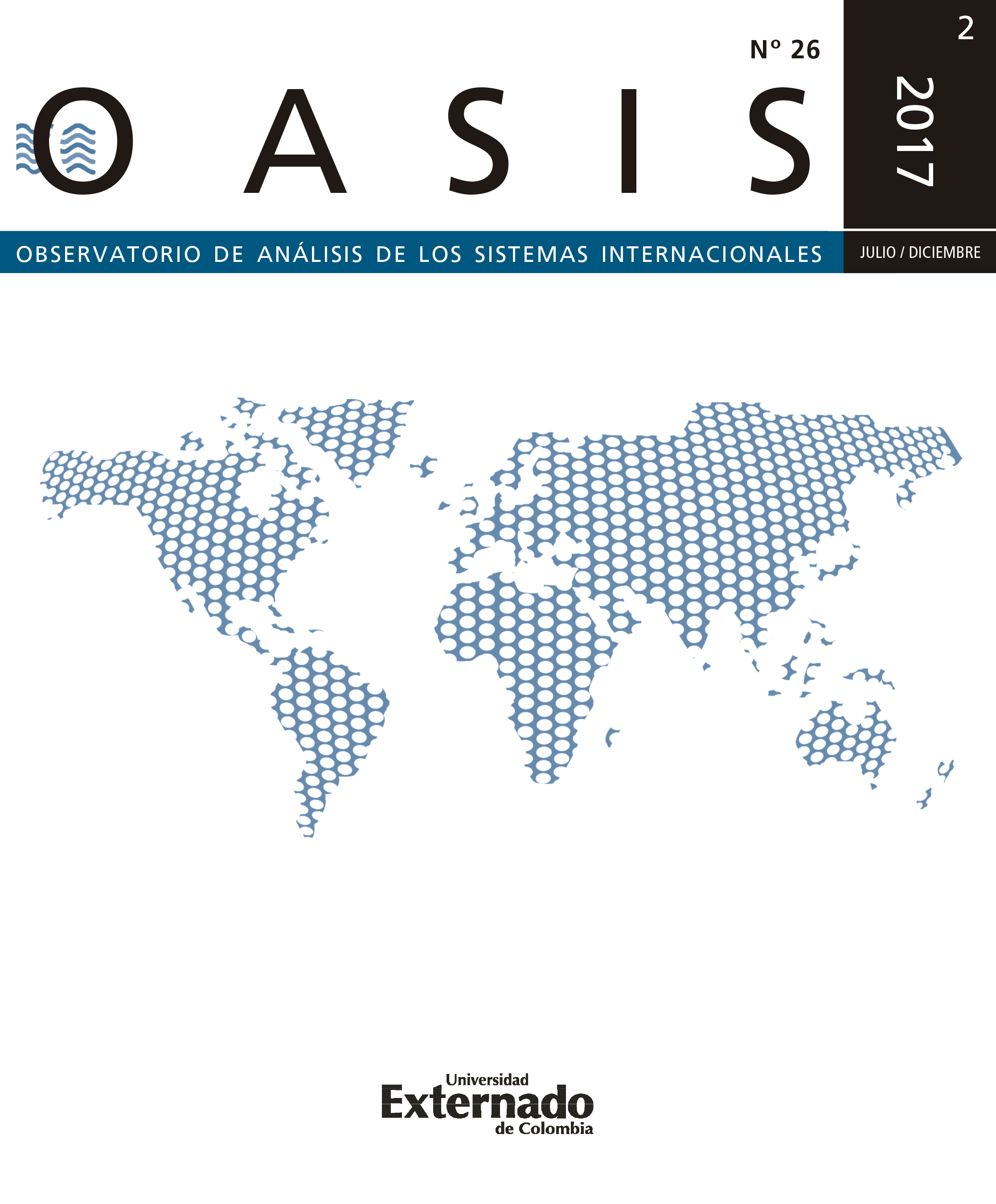L’impasse de la guerre afghane : Une perspective du réalisme structurel
The Impasse of the Afghan War: A Perspective from Structural Realism
Contenido principal del artículo
Resumen
L’engagement des États-Unis en sol afghan découle des prétentions de ce pays à réaffirmer sa puissance hégémonique; cependant, les raisons du maintien des troupes de l’otan, plus de quinze ans après l’invasion sont beaucoup moins évidentes. Les États-Unis n’ont effectivement pas réussi à éliminer, ni même diminuer, les actions des insurgés et le panorama politique s’est complexifié. L’objectif de cet article est donc d’analyser l’occupation afghan par les troupes l’otan à la lumière des postulats et concepts avancés par les réalistes structurels afin de faire une critique de la persistance de l’intervention militaire et de ses effets néfastes sur l’intérêt national des États-Unis. Pour répondre à l’objectif, j’analyse l’engagement des troupes en Afghanistan à la suite des attentats du 11 septembre 2001 et je critique de leur permanence dans ce pays à partir des postulats théoriques de Mearsheimer soutenant l’irrationalité de la poursuite de l’intervention militaire.
Palabras clave
Descargas
Detalles del artículo
Referencias / Ver
Anctil, P. (2015). Cuerpos femeninos en Afganistán: territorios de inseguridades y resistencia. Revista Corpo-grafías: Estudios críticos de y desde los cuerpos. 2 (2), 14-28.
Batistella, D. (2009). Théories des relations internationals (3e édition mise à jour et augmentée). Paris, France: Presses de Sciences Po.
Bush, G. W. (2001). Text of George Bush’s speech. The Guardian.
Chaudet, D. (2016). Quelle grande puissance pourrait amener la paix en Afghanistan? Le Huffington Post.
Cordesman, A. H. (2016). The Afghan War: Reshaping American Strategy and Finding Ways to Win. Centre for Strategic & International Studies.
ECP (2015). Barómetro 39 sobre conflictos y construcción de paz. Escola de Cultura de Pau.
Gannon, K. (2005). I is for infidel. From Holy war to Holy terror: 18 years inside Afghanistan. New York, United States: Public Affairs.
Gilpin, R. (1996). No one loves a political realist. Security Studies, 5 (3), 3-26.
Gul, A. (2016). Taliban: Peace Talks Not Possible Until Foreign ‘Occupation’ of Afghanistan Ends. Voa News.
HRW (2015). ‘Today We Shall All Die’: Afghanistan’s Strongmen and the Legacy of Impunity. United States: Human Rights Watch.
Jackson Jr., W. E. (2010). D-Day for the U.S. in Afghanistan: Realism vs. Idealism. The Huffington Post.
Jones, S. G. (2009). Playing Russian Roulette In Afghanistan. Fox News.
Jones, S. G. (2010). In the Graveyard of Empires: America’s War in Afghanistan, New York: Norton & Company.
Kennedy, P. (1988). The Rise and Fall of the Great Powers: Economic Change and Military Conflict from 1500 to 2000. London, Royaume-Uni : Unwin Hayman.
Macleod, A. (2010a). Le réalisme classique. Dans O’Meara, D. et Macleod, A. (eds.), Théories des relations internationales : Contestations et résistances (pp. 68-85). Québec: Athéna Éditions
Macleod, A. (2010b). Le réalisme néoclassique. Dans O’Meara, D. et Macleod, A. (eds.), Théories des relations internationales : Contestations et résistances (pp. 115-130). Québec: Athéna Éditions.
Madrid Chiriquá, M. (2012). Claves para comprender el conflicto afgano. Panamá América.
Mashal, M. (2016). How peace between Afghanistan and the Taliban foundered. The New York Times
Mearsheimer, J. J. (2015). We asked John Mearsheimer: What should be the purpose of American Power? The National Interest.
Mearsheimer, J. J. (2011). Imperial by Design. The National Interest, 111, 16-34.
Mearsheimer, J. J. (2009). How Afghanistan went from good war to bad. Newsweek.
Mearsheimer, J. J. (2006). Structural Realism. Dans Dunne, T., Kurki, M., et Smith, S. (eds.), International Relations Theories: Discipline and Diversity (pp. 71-88). Oxford: Oxford University Press.
Mearsheimer, J. J. (2001). Guns won’t win the afghan war. The New York Times.
Mearsheimer, J. J. (1994/95). The false promise of international institutions. International Security, 19 (3), 5-49.
Mearsheimer, J. J. et Walt, S. M. (2016).The case for offshore balancing a superior U.S. grand strategy, Foreign Affairs, July-August, 70-83.
Mearsheimer, J. J. et Walt, S. M. (2009). An unnecessary war. Foreign Policy.
Morgenthau, H. J. (1969). A new foreign policy for the United States. New York: Frederick A. Praeger.
Newland, S. J. et Johnson, D. V. (2007). The military and operational significance of the Weinberger Doctrine. Small wars & insurgencies, 1 (2). 171-190.
Obama, B. (2016). Statement by the President on Afghanistan. The White House.
Obama, B. (2009). Remarks by the President on a new strategy for Afghanistan and Pakistan. The White House.
Paris-Lopez, L. (2015). Open letter To President Obama: End the war in Afghanistan. The Raven Review.
Runion, M. L. (2007). The history of Afghanistan. Westport: Greenwood.
Schougen, P. (2012). Theory Talk #49: John Mearsheimer on power as the currency of international relations, disciplining US foreign policy, and being an independent variable. Theory Talks.
Smith, B. (2009a). Realists warn on Afghan war. Politico.
Smith, B. (2009b). Conservatives back Obama on Afghanistan. Politico.
Tripathi, D. (2014). Critical overview of nato’s role in Afghanistan. nato International School of Azerbaijan policy papers.
Walt, S. M. (2001/02). Beyond Bin Laden: Reshaping U.S. foreign policy. International Security, 26 (3), 56-78.
Watson Institute for International and Public Affairs (2016). Afghan civilians.









